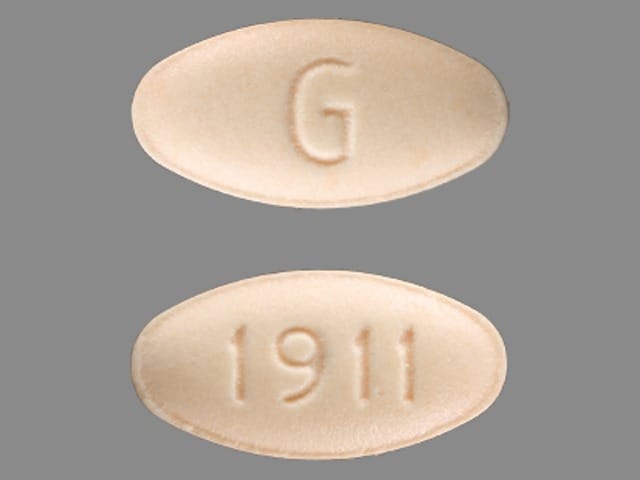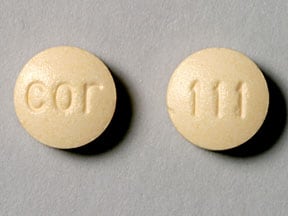Dosage Forms
Excipient information presented when available (limited, particularly for generics); consult specific product labeling. [DSC] = Discontinued product
Tablet, Oral, as hydrochloride:
Flumadine: 100 mg [DSC] [contains fd&c yellow #6 (sunset yellow), fd&c yellow #6 aluminum lake]
Generic: 100 mg
Pharmacology
Mechanism of Action
Exerts its inhibitory effect on three antigenic subtypes of influenza A virus (H1N1, H2N2, H3N2) early in the viral replicative cycle, possibly inhibiting the uncoating process; it has no activity against influenza B virus and is two- to eightfold more active than amantadine
Pharmacokinetics/Pharmacodynamics
Absorption
Oral: Well absorbed
Distribution
Vd: Children: 289 L (Anderson 1987); Adults: 727 to 768 L
Metabolism
Extensively hepatic via hydroxylation and glucuronidation
Excretion
Urine (<25% as unchanged drug)
Onset of Action
Antiviral activity: No data exist establishing a correlation between plasma concentration and antiviral effect
Time to Peak
6 hours
Half-Life Elimination
Children 5 to 8 years: 24.8 ± 9.4 hours (Anderson 1987)
Adults: 25.4 hours (range: 13 to 65 hours); Elderly (71 to 79 years of age): 32 hours (range: 20 to 65 hours)
Protein Binding
~40%, primarily to albumin
Use in Specific Populations
Special Populations: Renal Function Impairment
Cmax, AUC0 to Tau, and half-life increased by 75%, 81%, and 49%, respectively, in patients with severe renal impairment (CrCl 5 to 29 mL/minute). There was a 1.6-fold increase in half-life and 40% decrease in apparent Cl of rimantadine in hemodialysis patients.
Special Populations: Hepatic Function Impairment
AUC was about 3-fold larger, elimination half-life was about 2-fold longer, and apparent Cl was 50% lower in patients with severe hepatic impairment.
Special Populations: Elderly
In patients older than 70 years of age, the average AUC, peak concentrations, and elimination half-life at steady state were 20% to 30% higher.
Use: Labeled Indications
Influenza A virus, prophylaxis: Prophylaxis against influenza A virus in adults and children 1 year and older.
Influenza A virus, treatment: Treatment of illness caused by influenza A virus in adults.
Note: Due to high resistance rates, rimantadine is no longer recommended for the treatment or prophylaxis of influenza A (CDC 2018; IDSA [Uyeki 2019]). Please refer to the current CDC recommendations.
Contraindications
Hypersensitivity to rimantadine, other adamantanes (eg, amantadine), or any component of the formulation
Dosage and Administration
Dosing: Adult
Note: Due to high resistance rates, rimantadine is no longer recommended for the treatment or prophylaxis of influenza A (CDC 2018; IDSA [Uyeki 2019]). Please refer to the current CDC recommendations.
Influenza A virus, prophylaxis: Oral: 100 mg twice daily for 7 days after last known exposure. In institutional outbreaks, continue prophylaxis for at least 2 weeks and up to 7 days after the last known case identification. For prophylaxis after inactivated influenza vaccination, continue until immunity after vaccination develops (~2 weeks) (CDC/ACIP 2011).
Influenza A virus, treatment: Oral: 100 mg twice daily for 5 to 7 days. Note: Initiate within 48 hours of symptom onset (CDC/ACIP 2011).
Dosing: Geriatric
Note: Due to high resistance rates, rimantadine is no longer recommended for the treatment or prophylaxis of influenza A (CDC 2018; IDSA [Uyeki 2019]). Please refer to the current CDC recommendations.
Influenza A virus, prophylaxis/treatment: Oral: 100 mg once daily.
Dosing: Pediatric
Influenza A; prophylaxis: Note: Due to high levels of resistance in circulating influenza strains, rimantadine has not been recommended for prevention in the US over the past several years (CDC 2016); refer to current CDC/ACIP guidelines for updated recommendations. Monotherapy is not recommended. In order to control outbreaks in institutions, if influenza A virus subtyping is unavailable and oseltamivir-resistant viruses are circulating, rimantadine may be used in combination with oseltamivir if zanamivir cannot be used. Therapy should continue for ≥2 weeks and until ~10 days after illness onset in the last patient (CDC 2016; IDSA [Bradley 2011]; Harper 2009).
Children 1 to 9 years: Oral: 5 mg/kg/day in 1 to 2 divided doses; maximum daily dose: 150 mg/day (CDC 2016; IDSA [Bradley 2011])
Children ≥10 years and Adolescents: Oral: 5 mg/kg/day in 1 to 2 divided doses; maximum daily dose: 200 mg/day (CDC 2016; IDSA [Bradley 2011])
Influenza A infection; treatment: Note: Due to high levels of resistance in circulating influenza strains, rimantadine has not been recommended for treatment in the US over the past several years (CDC 2016); refer to current CDC/ACIP guidelines for updated recommendations. Optimal duration not established but typical duration of treatment is 5 to 7 days; discontinue as soon as clinically warranted to reduce the emergence of antiviral drug-resistant viruses.
Children 1 to 9 years: Oral: 6.6 mg/kg/day in 2 divided doses; maximum daily dose: 150 mg/day (IDSA [Bradley 2011])
Children ≥10 years and Adolescents: Oral: 5 mg/kg/day in 1 to 2 divided doses; maximum daily dose: 200 mg/day (IDSA [Bradley 2011])
Extemporaneously Prepared
Rimantadine 10 mg/mL Suspension:
To prepare suspension, 10 mL of Ora-Sweet® will be required for every 100 mg tablet of rimantadine. (Do not prepare more than a 14-day supply).
- Calculate the total dose needed (daily dose x number of days = mg of rimantadine needed) and round the final mg of rimantadine needed up to the next 100 mg (eg, 750 mg would be 800 mg, or eight 100 mg tablets).
- Calculate the total volume of Ora-Sweet® by taking the rounded mg of rimantadine and dividing by 10 mg/mL (eg, 800 mg divided by 10 mg/mL = 80 mL).
- Grind required number of tablets in mortar and triturate to a fine powder. Slowly add 1/3 of the total volume of Ora-Sweet® to the mortar and triturate until a uniform suspension is achieved.
- Transfer to an amber glass or PET plastic bottle. Slowly add another 1/3 of the total volume of Ora-Sweet® to the mortar, rinsing the mortar, then transferring the contents into the bottle. Repeat using the final 1/3 of Ora-Sweet®. Add additional vehicle to bottle, if needed, to achieve the total calculated volume.
- Shake well to ensure homogeneous suspension. Some inert ingredients in the tablet may be insoluble.
- Label: Shake gently prior to each use.
- Suspension is stable for 14 days when stored at room temperature (25°C/77°F).
Storage
Store at 25°C (77°F); excursions permitted to 15°C to 30°C (59°F to 86°F).
Rimantadine Images
Drug Interactions
Influenza Virus Vaccine (Live/Attenuated): Antiviral Agents (Influenza A and B) may diminish the therapeutic effect of Influenza Virus Vaccine (Live/Attenuated). Management: Avoid anti-influenza antivirals during the period beginning 48 hours prior to and ending 2 weeks after live influenza virus vaccine administration. Consider therapy modification
Adverse Reactions
1% to 10%:
Central nervous system: Insomnia (2% to 3%), lack of concentration (≤2%), dizziness (1% to 2%), nervousness (1% to 2%), fatigue (1%), headache (1%)
Gastrointestinal: Nausea (3%), anorexia (2%), vomiting (2%), xerostomia (2%), abdominal pain (1%)
Neuromuscular & skeletal: Weakness (1%)
<1%, postmarketing, and/or case reports: Abnormal gait, agitation, altered sense of smell, ataxia, bronchospasm, cardiac failure, confusion, cough, depression, diarrhea, drowsiness, dysgeusia, dyspepsia, dyspnea, euphoria, hallucination, heart block, hyperkinesia, hypertension, lactation, palpitations, pallor, pedal edema, seizure, skin rash, syncope, tachycardia, tinnitus, tremor
Warnings/Precautions
Disease-related concerns:
- Hepatic impairment: Use with caution in patients with hepatic impairment.
- Renal impairment: Use with caution in patients with renal impairment.
- Seizures: Use with caution in patients with a history of seizure disorder; an increase in seizure incidence may occur. Discontinue if seizures occur.
Special populations:
- Elderly: The elderly are at higher risk for CNS (eg, dizziness, headache, weakness) and gastrointestinal (eg, nausea/vomiting, abdominal pain) adverse events; dosage adjustment is recommended in patients >65 years of age.
Other warnings/precautions:
- Resistance: May develop during treatment; viruses exhibit cross-resistance between amantadine and rimantadine.
Monitoring Parameters
Monitor for CNS or GI effects in elderly or patients with renal or hepatic impairment
Pregnancy
Pregnancy Risk Factor
C
Pregnancy Considerations
Adverse events have been observed in animal reproduction studies. Untreated influenza infection is associated with an increased risk of adverse events to the fetus and an increased risk of complications or death to the mother. Neuraminidase inhibitors are currently recommended for the treatment or prophylaxis influenza in pregnant women and women up to 2 weeks postpartum. Appropriate antiviral agents are currently recommended as an adjunct to vaccination and should not be used as a substitute for vaccination in pregnant women (CDC 60[1] 2011; CDC March 13, 2014; CDC January 2015).
Health care providers are encouraged to refer women exposed to influenza vaccine, or who have taken an antiviral medication during pregnancy to the Vaccines and Medications in Pregnancy Surveillance System (VAMPSS) by contacting The Organization of Teratology Information Specialists (OTIS) at 1-877-311-8972.
Patient Education
- Discuss specific use of drug and side effects with patient as it relates to treatment. (HCAHPS: During this hospital stay, were you given any medicine that you had not taken before? Before giving you any new medicine, how often did hospital staff tell you what the medicine was for? How often did hospital staff describe possible side effects in a way you could understand?)
- Have patient report immediately to prescriber seizures.
- Educate patient about signs of a significant reaction (eg, wheezing; chest tightness; fever; itching; bad cough; blue skin color; seizures; or swelling of face, lips, tongue, or throat). Note: This is not a comprehensive list of all side effects. Patient should consult prescriber for additional questions.
Intended Use and Disclaimer: Should not be printed and given to patients. This information is intended to serve as a concise initial reference for health care professionals to use when discussing medications with a patient. You must ultimately rely on your own discretion, experience, and judgment in diagnosing, treating, and advising patients.





